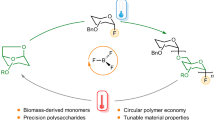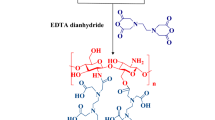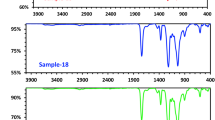Abstract
2,2,6,6-Tetramethylpiperidine-1-oxyl radical (TEMPO)-catalyzed oxidation enables efficient and position-selective conversion of primary hydroxy groups in water-soluble and water-insoluble polysaccharides to sodium carboxylate groups under mild conditions in water. TEMPO/NaBr/NaClO in water at pH 10 is an advantageous system in terms of the degrees of oxidation and reaction rates. TEMPO and NaBr behave as catalysts, and NaClO acts as the primary oxidant. However, oxidative depolymerization that is caused by the presence of NaBr and NaClO and the occurrence of side reactions on the polysaccharide molecules are unavoidable during oxidation. An alternative system is 4-acetamido-TEMPO/NaClO/NaClO2 in pH 5–7 buffer at 35–60 °C for 1–3 d, in which catalytic amounts of TEMPO and NaClO are used with NaClO2 as the primary oxidant. This oxidation system significantly inhibits depolymerization and yields oxidized products that contain no aldehydes. Various new water-soluble TEMPO-oxidized polysaccharides that contain significant amounts of sodium carboxylate groups have been prepared by TEMPO-catalyzed oxidation, and they have unique properties and functionalities. When crystalline native cellulose and chitin are oxidized by the TEMPO/NaBr/NaClO system under suitable conditions, the obtained water-insoluble oxidized products can be converted to various characteristic nanomaterials by mechanical disintegration in water, depending on the oxidation and disintegration conditions.
This is a preview of subscription content, access via your institution
Access options
Subscribe to this journal
Receive 12 print issues and online access
$259.00 per year
only $21.58 per issue
Buy this article
- Purchase on Springer Link
- Instant access to full article PDF
Prices may be subject to local taxes which are calculated during checkout











Similar content being viewed by others
References
Izydorczyk MS, Biliaders CG. Cereal arabinoxylans: advances in structure and physicochemical properties. Carbohydr Polym. 1995;28:33–48.
Kim UJ, Kuga S, Wada M, Okano T, Kondo T. Periodate oxidation of crystalline cellulose. Biomacromolecules. 2000;1:488–92.
de Nooy AEJ, Besemer AC, van Bekkum H. Highly selective nitroxyl radical-mediated oxidation of primary alcohol groups in water-soluble glucans. Carbohydr Res. 1995;269:89–98.
de Nooy AEJ, Besemer AC, van Bekkum H, van Dijk JAPP, Smit JAM. TEMPO-mediated oxidation of pullulan and influence of ionic strength and linear charge density on the dimensions of the obtained polyelectrolyte chains. Macromolecules. 1996;29:6541–7.
Trombotto S, Violet-Courtens E, Cottier L, Queneau Y. Oxidation of two major disaccharides: sucrose and isomaltulose. Top Catal. 2004;27:31–7.
Bragd PL, van Bekkum H, Besemer AC. TEMPO-mediated oxidation of oxidation of polysaccharides: Survey of methods and applications. Top Catal. 2004;27:49–65.
Tavernier ML, Delattre C, Petit E. Michaud P. β-(1,4)-Polyglucuronic acids—An overview. Open Biotechnol J. 2008;2:73–86.
Ponedel’kina IY, Khaibrakhmanova EA, Odinokov VN. Nitroxide-catalyzed selective oxidation of alcohols and polysaccharides. Russ Chem Rev. 2010;79:63–75.
Elboutachfaiti R, Delattre C, Petit E, Michaud P. Polyglucuronic acids: Structures, functions and degrading enzymes. Carbohydr Polym. 2011;84:1–13.
Pierre G, Punta C, Delattre C, Melone L, Dubessay P, Fiorati A, et al. TEMPO-mediated oxidation of polysaccharides: an ongoing story. Carbohydr Polym. 2017;165:71–85.
Isogai A, Hänninen T, Saito T, Fujisawa S. Catalytic oxidation of cellulose with nitroxyl radicals under aqueous conditions. Prog Polym Sci. 2018;86:122–48.
Shinoda R, Saito T, Okita Y, Isogai A. Relationship between length and degree of polymerization of TEMPO-oxidized cellulose nanofibrils. Biomacromolecules. 2012;13:842–9.
Mishra SP, Manent AS, Chabot B, Daneault C. The use of sodium chlorite in post-oxidation of TEMPO-oxidized pulp: Effect on pulp characteristics and nanocellulose yield. J Wood Chem Technol. 2012;32:137–48.
Takaichi S, Saito T, Tanaka R, Isogai A. Improvement of nanodispersibility of oven-dried TEMPO-oxidized celluloses in water. Cellulose. 2014;21:4093–103.
Takaichi T, Isogai A. Oxidation of wood cellulose using 2-azaadamantane N-oxyl (AZADO) or 1-methyl-AZADO catalyst in NaBr/NaClO system. Cellulose. 2013;20:1979–88.
Tamura N, Wada M, Isogai A. TEMPO-mediated oxidation of (1→3)-β-D-glucans. Carbohydr Polym. 2009;77:300–5.
Hirota M, Tamura N, Saito T, Isogai A. Oxidation of regenerated cellulose with NaClO2 catalyzed by TEMPO and NaClO under acid-neutral conditions. Carbohydr Polym. 2009;78:330–5.
Saito T, Hirota M, Tamura N, Kimura S, Fukuzumi H, Heux L, et al. Individualization of nano-sized plant cellulose fibrils by direct surface carboxylation using TEMPO catalyst under neutral conditions. Biomacromolecules. 2009;10:1992–6.
Tamura N, Hirota M, Saito T, Isogai A. Oxidation of curdlan and other polysaccharides by 4-acetamide-TEMPO/NaClO/NaClO2 under acid conditions. Carbohydr Polym. 2010;81:592–8.
Ye W, Hu Y, Ma H, Liu L, Yu J, Fan Y. Comparison of cast films and hydrogels based on chitin nanofibers prepared using TEMPO/NaBr/NaClO and TEMPO/NaClO/NaClO2 systems. Carbohydr Polym. 2020;237:116125.
Xu S, Song Z, Qian X, Shen J. Introducing carboxyl and aldehyde groups to softwood-derived cellulosic fibers by laccase/TEMPO-catalyzed oxidation. Cellulose. 2013;20:2371–8.
Pei J, Yin Y, Shen Z, Bu X, Zhang F. Oxidation of primary hydroxyl groups in chitooligomer by a laccase-TEMPO system and physico-chemical characterisation of oxidation products. Carbohydr Polym. 2016;135:234–8.
Yu Y, Wang Q, Yuan J, Fan X, Wang P. A novel approach for grafting of β-cyclodextrin onto wool via laccase/TEMPO oxidation. Carbohydr Polym. 2016;153:463–70.
Parikka K, Nikkiä I, Pitkänen L, Ghafar A, Sontag-Strohm T. Laccase/TEMPO oxidation in the production of mechanically strong arabinoxylan and glucomannan aerogels. Carbohydr Polym. 2017;175:377–86.
Isogai T, Saito T, Isogai A. TEMPO electromediated oxidation of some polysaccharides including regenerated cellulose fiber. Biomacromolecules. 2010;11:1593–9.
Isogai T, Saito T, Isogai A. Wood cellulose nanofibrils prepared by TEMPO electro-mediated oxidation. Cellulose. 2011;18:421–31.
Isogai A, Kato Y. Preparation of polyuronic acid from cellulose by TEMPO-mediated oxidation. Cellulose. 1998;4:153–64.
Tahiri C, Vignon M. TEMPO-oxidation of cellulose: synthesis and characterization of polyglucuronans. Cellulose. 2000;7:177–88.
da Silva Perez D, Montanari S, Vignon MR. TEMPO-mediated oxidation of cellulose III. Biomacromolecules. 2003;4:1417–25.
Isogai T, Yanagisawa M, Isogai A. Degrees of polymerization (DP) and DP distribution of cellouronic acids prepared from alkali-treated celluloses and ball-milled native celluloses by TEMPO-mediated oxidation. Cellulose. 2009;16:117–27.
Zang K, Fischer S, Geissler A, Brendler E. Analysis of carboxylate groups in oxidized never-dried cellulose II catalyzed by TEMPO and 4-acetamide-TEMPO. Carbohydr Polym. 2012;87:894–900.
Tang Z, Li W, Lin X, Xiao H, Miao Q, Huang L, et al. TEMPO-oxidized cellulose with high degree of oxidation. Polym-Basel. 2017;9:421.
Kato Y, Habu N, Yamaguchi J, Kobayashi Y, Shibata I, Isogai A, et al. Biodegradation of β−1,4-linked polyglucuronic acid (cellouronic acid). Cellulose. 2002;9:75–81.
Konno N, Ishida T, Igarashi K, Fushinobu S, Samejima M, Isogai A. Crystal structure of polysaccharide lyase family 20 endo-β−1,4-glucuronan lyase from the filamentous fungus Trichoderma reesei. FEBS Lett. 2009;583:1323–6.
Takaichi S, Hiraoki R, Inamochi T, Isogai A. One-step preparation of sodium 2,3,6-tricarboxylate cellulose. Carbohydr Polym. 2014;110:499–504.
Parks EJ, Hebert RL. Thermal analysis of ion exchange reaction products of wood pulps with calcium and aluminum cations. TAPPI J. 1972;55:1510–4.
Isogai A, Saito T, Fukuzumi H. TEMPO-oxidized cellulose nanofibers. Nanoscale. 2011;3:71–85.
Isogai A. Nanocelluloses: Fundamentals and applications of new bio-based nanomaterials. J Wood Sci. 2013;59:449–59.
Isogai A. Review: development of completely dispersed cellulose nanofibers. Proc Jpn Acad Ser B. 2018;94:161–79.
Isogai A, Zhou Y. Diverse nanocelluloses prepared from TEMPO-oxidized wood cellulose fibers: nanonetworks, nanofibers, and nanocrystals. Curr Opin Solid St M. 2019;23:101–6.
Isogai A. Emerging nanocellulose technologies: recent developments. Adv Mater. 2021;33:2000630.
Li T, Chen C, Brozena AH, Zhu JY, Xu L, Driemeier C, et al. Fibrillated cellulose nanotechnologies: competitive performance beyond sustainability. Nature. 2021;590:47–56.
Okita Y, Saito T, Isogai A. TEMPO-mediated oxidation of softwood thermomechanical pulp. Holzforschung. 2009;63:529–35.
Okita Y, Saito T, Isogai A. Entire surface oxidation of various cellulose microfibrils by TEMPO-mediated oxidation. Biomacromolecules. 2010;11:1696–700.
Li L, Zhao S, Zhang Z, Hu H, Kim JK. TEMPO-mediated oxidation of MCC at high temperature: Synthesis and characterization of high-hydrophilic polymer. Fiber Polym. 2012;13:1–7.
Puangsin B, Yang Q, Saito T, Isogai A. Comparative characterization of cellulose nanofibril films prepared from non-wood celluloses by TEMPO-mediated oxidation. Int J Biol Macromol. 2013;59:208–13.
Li L, Zhao S, Zhen J, Zhang ZX, Hu H, Xin Z, et al. TEMPO-mediated oxidation of microcrystalline cellulose: Influence of temperature and oxidation procedure on yields of water-soluble products and crystal structures of water-insoluble residues. Fiber Polym. 2013;14:352–7.
Kuramae R, Saito T, Isogai A. TEMPO-oxidized cellulose nanofibrils prepared from various plant holocelluloses. React Funct Polym. 2015;85:126–33.
Hiraoki R, Ono Y, Saito T, Isogai A. Molecular mass and molecular-mass distribution of TEMPO-oxidized celluloses and TEMPO-oxidized cellulose nanofibrils. Biomacromolecules. 2015;16:675–81.
Zhou Y, Saito T, Bergström L, Isogai A. Acid-free preparation of cellulose nanocrystals by TEMPO oxidation and subsequent cavitation. Biomacromolecules. 2018;19:633–9.
Zhou Y, Ono Y, Takeuchi M, Isogai A. Changes to the contour length, molecular chain length, and solid-state structures of nanocellulose resulting from sonication in water. Biomacromolecules. 2020;21:2346–55.
Ono Y, Takeuchi M, Zhou Y, Isogai A. TEMPO/NaBr/NaClO and NaBr/NaClO oxidations of cotton linters and ramie celluloses. Cellulose. 2021;28:6035–49.
Saito T, Hirota M, Tamura N, Kimura S, Fukuzumi H, Heux L, et al. Individualization of nano-sized plant cellulose fibrils by direct surface carboxylation using TEMPO catalyst under neutral conditions. Biomacromolecules. 2009;10:1992–6.
Tanaka R, Saito T, Isogai A. Cellulose nanofibrils prepared from softwood cellulose by TEMPO/NaClO/NaClO2 systems in water at pH 4.8 or 6.8. Int J Biol Macromol. 2012;51:228–34.
Jaušovec D, Vogrinčič R, Kokol V. Introduction of aldehyde vs. carboxylic groups to cellulose nanofibers using laccase/TEMPO mediated oxidation. Carbohydr Polym. 2015;116:74–85.
Jiang J, Ye W, Liu L, Wang Z, Fan Y, Saito T, et al. Cellulose nanofibers prepared by TEMPO/laccase/O2 system. Biomacromolecules. 2017;18:288–94.
Praskalo J, Kostic M, Potthast A, Popov G, Pejic B, Skundric P. Sorption properties of TEMPO-oxidized natural and man-made cellulose fibers. Carbohydr Polym. 2009;77:791–8.
Hirota M, Tamura N, Saito T, Isogai A. Water dispersion of cellulose II nanocrystals prepared by TEMPO-mediated oxidation of mercerized cellulose at pH 4.8. Cellulose. 2010;17:279–88.
Hirota M, Tamura N, Saito T, Isogai A. Cellulose II nanocrystals prepared from fully mercerized, partially mercerized and regenerated celluloses by 4-acetamido-TEMPO/NaClO/NaClO2 oxidation. Cellulose. 2011;19:435–42.
Milanovic J, Schiehser S, Milanovic P, Potthast A, Kostic M. Molecular weight distribution and functional group profiles of TEMPO-oxidized lyocell fibers. Carbohydr Polym. 2013;98:444–50.
Funahashi R, Okita Y, Hondo H, Zhao M, Saito T, Isogai A. Different conformations of surface cellulose molecules in native cellulose microfibrils revealed by layer-by-layer peeling. Biomacromolecules. 2018;18:3687–94.
Ono Y, Fukui S, Funahashi R, Isogai A. Relationship of distribution of carboxy groups to molar mass distribution of TEMPO-oxidized algal, cotton, and wood cellulose nanofibrils. Biomacromolecules. 2019;20:4026–34.
Ono Y, Nakamura Y, Zhou Y, Horikawa Y, Isogai A. Linear and branched structures present in high-molar-mass fractions in holocelluloses prepared from chara, haircap moss, adiantum, ginkgo, Japanese cedar, and eucalyptus. Cellulose. 2021;28:3935–49.
Hirota M, Furihata K, Saito T, Kawada T, Isogai A. Glucose/glucuronic acid alternating copolysaccharide prepared from TEMPO-oxidized native celluloses by surface-peeling. Angew Chem Int Ed. 2010;49:7670–2.
Kitaoka T, Isogai A, Onabe F. Chemical modification of pulp fibers by TEMPO-mediated oxidation. Nord Pulp Pap Res J. 1999;14:274–9.
Yui Y, Tanaka C, Isogai A. Functionalization of cotton fabrics by TEMPO-mediated oxidation. Sen’i Gakkaishi. 2013;69:222–8.
Tanaka C, Yui Y, Isogai A. TEMPO-mediated oxidation of cotton cellulose fabrics under weakly acidic or neutral conditions. Sen’i Gakkaishi. 2015;71:191–6.
Tanaka C, Yui Y, Isogai A. TEMPO-mediated oxidation of cotton cellulose fabrics with sodium dichloroisocyanurate. J Fiber Sci Technol. 2016;72:172–8.
Wakabayashi M, Fujisawa S, Saito T, Isogai A. Nanocellulose film properties tunable by controlling degree of fibrillation of TEMPO-oxidized cellulose. Front Chem. 2020;8:37.
Kato Y, Kaminaga J, Matsuo R, Isogai A. TEMPO-mediated oxidation of chitin, regenerated chitin and N-acetylated chitosan. Carbohydr Polym. 2004;58:421–6.
Sun L, Du Y, Yang J, Shi X, Li J, Wang X, et al. Conversion of crystal structure of the chitin to facilitate preparation of a 6-carboxychitin. Carbohydr Polym. 2006;66:168–75.
Bordenave N, Grelier S, Coma V. Advances on selective C-6 oxidation of chitosan by TEMPO. Biomacromolecules. 2008;9:2377–82.
Fan Y, Saito T, Isogai A. Chitin nanocrystals prepared by TEMPO-mediated oxidation of α-chitin. Biomacromolecules. 2008;9:192–8.
Fan Y, Fukuzumi H, Saito T, Isogai A. Comparative characterization of aqueous dispersions and cast films of different chitin nanowhiskers/nanofibers. Int J Biol Macromol. 2012;50:69–76.
Pierre G, Salah R, Gardarin C, Traikia M, Petit E, Delort AM, et al. Enzymatic degradation and bioactivity evaluation of C-6 oxidized chitosan. Int J Biol Macromol. 2013;60:383–92.
Sun X, Zhu J, Gu Q, You Y. Surface-modified chitin by TEMPO-mediated oxidation and adsorption of Cd(III). Colloid Surf A. 2018;555:103–10.
Jiang J, Ye W, Yu J, Fan Y, Ono Y, Saito T, et al. Preparation of chitin nanocrystals using the O2/laccase/TEMPO system. Carbohydr Polym. 2018;189:178–83.
Ye W, Hu Y, Ma H, Liu L, Yu J, Fan Y. Comparison of cast films and hydrogels based on chitin nanofibers prepared using TEMPO/NaBr/NaClO and TEMPO/NaClO/NaClO2 systems. Carbohydr Polym. 2020;237:116125.
Delattre C, Rios L, Laroche C, Le NHT, Lecerf D, Picton L, et al. Production and characterization of new families of polyglucuronic acids from TEMPO-NaOCl oxidation of curdlan. Int J Biol Macromol. 2009;45:458–62.
Watanabe E, Tamura N, Saito T, Habu N, Isogai A. Preparation of completely C6-carboxylated curdlan by catalytic oxidation with 4-acetamido-TEMPO. Carbohydr Polym. 2014;100:74–9.
Yan JK, Ma HL, Cai PF, Zhang HN, Zhang Q, Hu NZ, et al. Structural characteristics and antioxidant activities of different families of 4-acetamido-TEMPO-oxidised curdlan. Food Chem. 2014;143:530–5.
Yan JK, Pei JJ, Ma HL, Wang ZB. Effects of ultrasound on molecular properties, structure, chain conformation and degradation kinetics of carboxylic curdlan. Carbohydr Polym. 2015;121:64–70.
Tang R, Hao J, Zong R, Wu F, Zeng Y, Zhang Z. Oxidation pattern of curdlan with TEMPO-mediated system. Carbohydr Polym. 2018;186:91–6.
Kato Y, Matsuo R, Isogai A. Oxidation process of water-soluble starch in TEMPO-mediated system. Carbohydr Polym. 2003;51:69–75.
Hao J, Wu F, Tang R, Sun Y, Liu D, Zhang Z. Preparation of 1,4-linked α-D-glucuronans from starch with 4-acetamide-TEMPO/NaClO2/NaClO system. Int J Biol Macromol. 2020;151:740–6.
Yui T, Uto T, Nakauchida T, Yamamoto K, Kadokawa J. Double helix formation from non-natural amylose analog polysaccharides. Carbohydr Polym. 2018;189:184–9.
Fraschini C, Vignon MR. Selective oxidation of primary alcohol groups of β-cyclodextrin mediated by 2,2,6,6-tetramethylpiperidine-1-oxyl radical (TEMPO). Carbohydr Res. 2000;328:585–9.
Yu Y, Wang Q, Yuan J, Fan X, Wang P. A novel approach for grafting of β-cyclodextrin onto wool via laccase/TEMPO oxidation. Carbohydr Polym. 2016;153:463–70.
Jiang B, Drouet E, Milas M, Rinaudo M. Study on TEMPO-mediated selective oxidation of hyaluronan and the effects of salt on the reaction kinetics. Carbohydr Res. 2000;327:455–61.
Sierakowski MR, Milas M, Desbrires J, Rinaudo M. Specific modifications of galactomannans. Carbohydr Polym. 2000;42:51–7.
Sakakibara CN, Sierakowski MR, Lucyszyn N, Freitas RA. TEMPO-mediated oxidation on galactomannan: Gal/Man ratio and chain flexibility dependence. Carbohydr Polym. 2016;153:371–8.
Parikka K, Nikkiä I, Pitkänen L, Ghafar A, Sontag-Strohm T. Laccase/TEMPO oxidation in the production of mechanically strong arabinoxylan and glucomannan aerogels. Carbohydr Polym. 2017;175:377–86.
Elboutachfaiti R, Petit E, Beuvian C, Courtois B, Coutois J, Delattre C. Development of new ulvan-like polymer by regioselective oxidation of gellan exopolysaccharide using TEMPO reagent. Carbohydr Polym. 2010;80:485–90.
Elboutachfati R, Petit E, Pillon M, Coutois B, Courtois J, Delattre C. Evaluation of antioxidant capacity of ulvan-like polymer obtained by regioselective oxidation of gellan exopolysaccharide. Food Chem. 2011;127:976–83.
Su Y, Chu B, Gao Y, Wu C, Zhang L, Chen P, et al. Modification of agarose with carboxylation and grafting dopamine for promotion of its cell-adhesiveness. Carbohydr Polym. 2013;92:2245–51.
Pereira JM, Mahoney M, Edgar KJ. Synthesis of amphiphilic 6-carboxypullulan ethers. Carbohydr Polym. 2014;100:65–73.
Spatareanu A, Bercea M, Budtova T, Harabagiu V, Sacarescu L, Coseri S, et al. Synthesis, characterization and solution behavior of oxidized pullulan. Carbohydr Polym. 2014;111:63–71.
Coseri S, Bercea M, Harabagiu V, Budtova T. Oxidation vs. degradation in polysaccharides: Pullulan – A case study. Eur Polym J 2016;85:82–91.
Delattre C, Pierre G, Gardarin C, Traikia M, Elboutachfaiti R, Isogai A, et al. Antioxidant activities of a polyglucuronic acid sodium salt obtained from TEMPO-mediated oxidation of xanthan. Carbohydr Polym. 2015;116:34–41.
Demuth T, Boulos S, Nyström L. Structural investigation of oxidized arabinoxylan oligosaccharides by negative ionization HILIC-qToF-MS. Analyst. 2020;145:6691–704.
Pandeirada CO, Merkx DWH, Janssen HG, Westphal Y, Schols HA. TEMPO/NaClO2/NaClO oxidation of arabinoxylans. Carbohydr Polym. 2021;259:117781.
dos Santos-Fidencio GC, Gonçalves AG, Noseda MD, Duarte MER, Ducatti DRB. Effects of carboxyl group on the anticoagulant activity of oxidized carrageenans. Carbohydr Polym. 2019;214:286–93.
Jin W, He X, Wu W, Bao Y, Wang S, Cai M, et al. Structural analysis of a glucoglucuronan derived from laminarin and the mechanisms of its anti-lung cancer activity. Int J Biol Macromol. 2020;163:776–87.
Spier VC, Sierakowski MR, Reed WF, de Freitas RA. Polysaccharide depolymerization from TEMPO-catalysis: Effect of TEMPO concentration. Carbohydr Polym. 2017;170:140–7.
Acknowledgements
We thank Edanz (https://jp.edanz.com/ac) for editing a draft of this manuscript.
Author information
Authors and Affiliations
Corresponding author
Ethics declarations
Conflict of interest
The author declares no competing interests.
Additional information
Publisher’s note Springer Nature remains neutral with regard to jurisdictional claims in published maps and institutional affiliations.
Rights and permissions
About this article
Cite this article
Isogai, A. TEMPO-catalyzed oxidation of polysaccharides. Polym J 54, 387–402 (2022). https://doi.org/10.1038/s41428-021-00580-1
Received:
Revised:
Accepted:
Published:
Issue Date:
DOI: https://doi.org/10.1038/s41428-021-00580-1
This article is cited by
-
Influence of TEMPO-oxidation on pulp fiber chemistry, morphology and mechanical paper sheet properties
Cellulose (2024)
-
Simultaneous/direct chemomechanical densification and downsizing of weak paulownia wood to produce a strong, unidirectional, all-wooden nanocomposite
Polymer Journal (2023)
-
Molar masses and molar mass distributions of commercial regenerated cellulose materials and softwood dissolving pulp determined by SEC/MALLS
Cellulose (2023)
-
Effects of an aqueous surface modification via a grafting-through polymerization approach on the fibrillation and drying of bleached softwood kraft pulp
Cellulose (2023)
-
Ionic liquid-assisted synthesis of chitin–ethylene glycol hydrogels as electrolyte membranes for sustainable electrochemical capacitors
Scientific Reports (2022)



